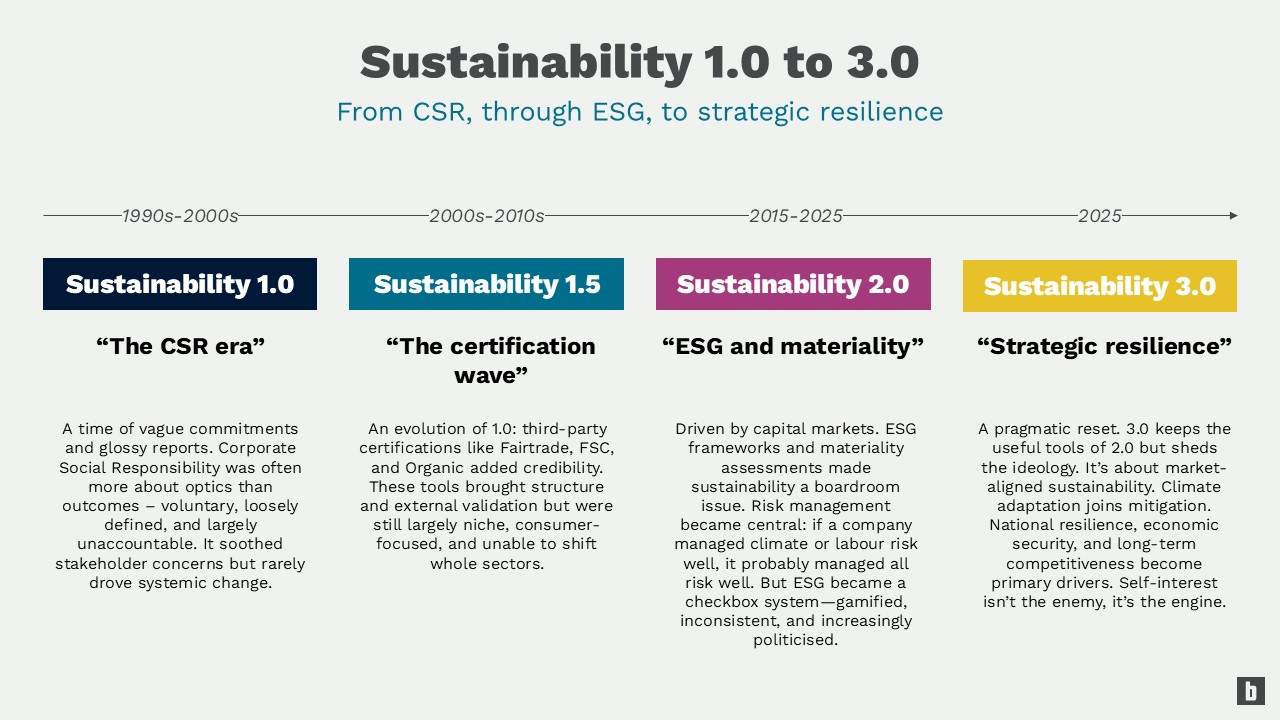Stefan Colligan, Principal Consultant, asks whether “ESD” might be a more practical framework for sustainability communicators than ESG. This blog forms part of our Sustainability 3.0 series of insights and perspectives on sustainability and impact comms in a time of upheaval and culture war chaos.
If you’re working in sustainability, corporate communications, or investor relations, you’ve experienced the tension around ESG.
The term has become a political lightning rod. On one end of the spectrum, it’s a woke distraction that prioritises liberal agendas over the deepening of shareholders’ pockets. On the other, it’s a bureaucratic maze of legislative complexity, metrics and disclosures, abstract or unmoored from the present moment, from reality.
And when ESG strategy is communicated to people – not just “stakeholders” or “consumers,” but actual real human beings – via investor decks, corporate narratives or brand campaigns – the message often feels too vague, too performative, too cosmetic.
But here’s the thing: the intent behind ESG still matters.
What’s missing is the relevance, urgency, and strategic integration – especially in world defined by international crises, supply chain vulnerabilities, and rapid technological change.
That’s where ‘ESD’ – “Emerging, Strategic, Disruptive” factors – can offer a fresh perspective.
ESD – according to analysts at Bernstein – isn’t about replacing ESG; it’s a reframing that helps us understand how multiple, overlapping risks – climate, technology, geopolitics, social instability – interact to shape long-term resilience.
As a reminder, ESG strategy and financial strategy are not separate. They exist on the same continuum and should be approached as such. There’s a strong case for moving beyond the habit of treating environmental and social issues as stand-alone concerns.
In reality, the “E” and “S” of ESG are deeply intertwined with other board-level priorities – from geopolitical volatility to national security. Ignoring those overlaps means missing the full strategic picture.
Take energy, for example: investing in clean, locally produced renewables isn’t just a sustainability play; it’s also a smart move for energy independence and resilience in an increasingly unstable world.
We can’t separate these risks; we need to connect them.
And that shift matters not just for strategy, but for storytelling.
Communicators have a critical role to play in making this real for investors, employees, and the public. We’re tired of saying it, but sustainability is not a “nice to have,” it’s foundational to long-term value and survival. The clue is in the name – from the Latin sustinere, meaning “to hold up” or “to maintain”- the capacity to endure over time.
That message lands best when it’s framed in terms of real-world risks and consequences, not just compliance or corporate goodwill.
To be clear, this isn’t about ditching ESG. It’s about moving beyond the box-tick and embracing a more integrated, realistic way of thinking. If ESD helps us connect the dots more effectively – between sustainability, strategy, and security – then communicators should be leading that shift.
So yes, ESD might just be the framework we need to guide our thinking in this Sustainability 3.0 world. And for those of us shaping the narrative, it offers a sharper lens – not just for what we say, but for how we help organisations act.
